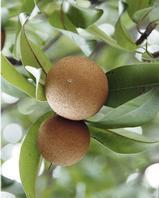Tesi Johnson, Gleaner Writer

Naseberries - RUDOLPH BROWN/CHIEF PHOTOGRAPHER
Call it what you may, but the brown scruffy fruit is a delightful sweet treat that is as intriguing as it is tasty. And, it is in season right now.
THE NASEBERRY, or sapodilla tree, is native to Mexico and Central America, and is found from the Yucatan Peninsula to Costa Rica. The exact time of its introduction to the Caribbean is unclear, but it has long become a part of the Jamaican and Caribbean cuisine - and is found all across the Jamaican landscape, especially during the ripening season. At the intersections uptown, in the markets, the Bog Walk gorge, or any countryparts for that matter, vendors offer up the brown-skinned fruit in the dozen or half-dozen, or singles if you may.
The fruit is round to egg-shaped and the skin is brown and scruffy when ripe. The flesh varies from yellow to shades of brown and sometimes reddish-brown, and may be smooth or of a granular texture, much like an American pear. When fully ripe, it has a sweet and pleasant flavour, and has high dietary fibre content. When immature, it is hard, gummy and very astringent.
Now that you have a full description, let's hope that you won't purchase a bag of Irish potatoes mistakenly believing that they are naseberries, as one culturally uninformed Ms. Jamaica Universe contestant admitted to having done.
The tree is large and slow growing and thrives in both humid and dry conditions. Its ability to thrive on poor soils makes it an ideal fruit tree for less-than-optimum growing areas, and the tree may grow as tall as 30 metres in Jamaica.
WHEN TO PICK A NASEBERRY
It is rather irksome to find beautiful naseberries smashed all over the ground, when they should be piled up in your pantry. Unfortunately, most people find it difficult to tell when a naseberry is ready to be picked. Don't let the bats get to them before you do.
The best time to pick them is when they are mature but not yet fully ripe and softened. One way to know when it has reached this state is to observe the slight yellow or peach colour of the ripe skin. Also, you may rub the 'scruf' to see if it loosens readily and then scratch the fruit to ensure the skin is not green beneath the 'scruf'. The mature fruit should separate from the stem easily without leaking of the latex. At this point it should still be hard and must be kept at room temperature for a few days to soften.
It is best to wash off the sandy scruf before putting the fruit aside to ripen. The common practice is to wrap them in newspaper and put away in a dark area, probably a cupboard, where they can soften. A fruit that is picked when mature will ripe to perfection but a fruit picked immature will shrivel as they soften and will be of poor quality, sometimes with small pockets of gummy latex, or 'stain' as Jamaicans call it.

